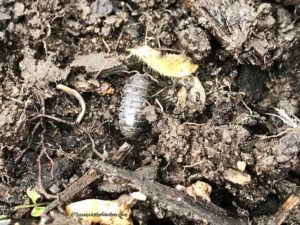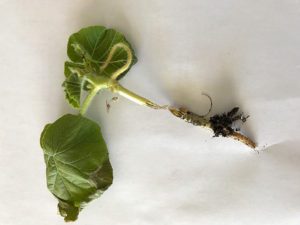Pillbugs, Sowbugs
Latin name: (Pillbugs) Armadillium vulgare; (Sowbugs) Porcellio scaber, P. laevis, Onciscus asellus
Size: About 1/4″ to 1/3″ long
Color: Brown to silver
Introduction: Pillbugs and sowbugs are interesting because they are both crustaceans that have adapted to living on land. Pillbugs have the nickname of “rolly pollies” or “roly polies” and have straight edges at the lower edge of their plates, whereas sowbugs (pictured in photo) have more of a jagged lower edge of the plates. They are generally considered to be benign (or even beneficial) because they serve an important role in the decomposition of organic material in the garden. However, as you will read in the blog posts I’ve linked to at the bottom, you’ll learn they also have a reputation for chewing on the stems of succulent young seedlings. So, if they’re not causing you problems, leave them alone. If they are, read on for information on how to control them.
Life cycle: Both are nocturnal and typically seen under moist, decaying matter in the garden or around structures. The eggs are carried in their mother’s abdominal pouch for 3 to 4 weeks before hatching. After leaving the pouch, they molt 4 to 5 times over the course of a year before becoming an adult. Their lifespan is about 2 years.
Signs of their activity: Seedlings that aren’t thriving, wilting leaves and nibbled stems (see photo below).
Typically seen on: Cucurbit-family vegetable crops such as cucumbers, melons, summer/winter squash and pumpkins. I’ve also noticed damaged from them on bean and broccoli seedlings. They cause the most damage on young seedlings; as the plants grow and “toughen up,” the pillbugs and sowbugs move along.
Controls: Apply diatomaceous earth at the base of the bothered seedlings’ main stems. Hand-pick off the seedlings as well if the bugs are causing damage.
Natural predators: None found.
Additional information: PennState Extension Sowbugs and Pillbugs: Occasional But Destructive Greenhouse Pests. Washington State University Hortsense Sowbugs, Pillbugs and Millipedes. Also posts from SusansintheGarden: Those Darned Pillbugs! and Problems with Pillbugs.
Back to Organic Pest Control


